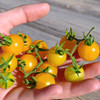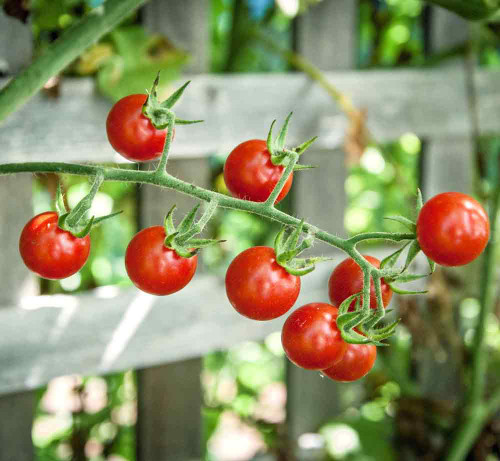Wild Galapagos Tomato Seeds - (Solanum cheesmaniae)
- SKU:
- V1182
- Seed Count:
- Approx 25 seeds per pack
- Days to Maturity:
- 70 days
- Type:
- Indeterminate
- Size:
- Currant
- Color:
- Yellow - Orange
- Days to Germination:
- 5 - 21 days @ 75-95F
- Light Preference:
- Full sun
- Plant Spacing:
- 12"
- Status:
- Heirloom, Non-Hybrid, Non-GMO seeds
Description
Wild Galapagos Tomato - Bring the Wild Home to Your Garden
There is a tomato that is so unique that it caught the attention of Charles Darwin himself! In 1835, Darwin first collected specimens of this wild tomato from the lava flows and rugged terrain of the Galapagos Islands. Officially known as Solanum cheesmaniae, the Wild Galapagos tomato thrives in challenging volcanic soils and arid climates. Its resilience has even made it a favorite food of the iconic Galapagos Island tortoises. Growing this rare heirloom in your garden is a unique opportunity to savor a taste of the Galapagos' incredible biodiversity.
This intensely sweet and complex fruit is remarkably resistant to many tomato pests. Its flavor surpasses many other small-fruited varieties, and its abundant clusters will produce almost faster than you can harvest them.
The Wild Galapagos tomato demonstrates remarkable resilience across a wide range of climates. It continues producing even in scorching Texas summers, with temperatures soaring above 110°F for over 40 days. Our customers report yields of two pints of tomatoes every other day from just two plants!
Meanwhile, at the other end of the spectrum, our customers in the northern tip of Idaho, southern Alaska, marvel at its cold hardiness. It's the first to flower and set fruit in the spring and the last to succumb to frost in the fall, consistently delivering a dependable harvest.
Details
This heirloom tomato is a robust plant that can grow up to three feet tall and wide and thrives in containers or smaller garden beds, making it perfect for those with limited space. Despite its small stature, this bushy plant offers an abundant harvest of small, round, yellow-orange fruits. It can have a more sprawling growth habit in favorable climates but can be trimmed back as needed. The leaves are typically lime green to dark green, adding to the plant's overall hardiness. The small, pale yellow flowers are a delicate contrast to the vigorous foliage.
It is an indeterminate variety that perfectly balances sweetness and acidity. Remarkably resilient, it tolerates salt, drought, and poor soil conditions. A true champion in the garden, it's often the first to ripen and the last to surrender to the cold. Even in partial shade, it produces consistently high-quality, crack-resistant fruit.
History
The tomato's journey began in the heart of South America, where the ancient Inca civilization first cultivated this fruit as early as 500 BC. Domesticated for its culinary value, the tomato gradually spread throughout Central and South America. Christopher Columbus, in 1493, became the first European to encounter this New World treasure. By the 16th century, Spanish explorers had introduced tomato seeds to Europe and, soon after, to Africa. Over time, the tomato's popularity grew, establishing it as a beloved staple in kitchens worldwide.
However, the Wild Galapagos tomato has a unique tale of its own. Isolated on the volcanic Galapagos Islands, this resilient variety adapted to the harsh environment, developing distinct characteristics that captivated even Charles Darwin. In the early 1950s, Zouzou Caray discovered the ancestors of the yellow-orange variety we know today. This discovery sparked a chain of sharing among passionate individuals like Alf Kastdalen, a Norwegian settler, and Dr. Robert Bowman of San Francisco State College, ultimately leading to its study and preservation at UC Davis.
Uses
The bright, tangy flavor of the Wild Galapagos tomato makes it incredibly versatile in the kitchen. Its small size is perfect for popping straight into your mouth for a pop of flavor or tossing whole into salads for a bright counterpoint. The intense, sweet yet salty flavor profile shines in salsas and sauces and is a surprising addition to your favorite seafood dishes. Don't let any extra tomatoes go to waste! They are ideal for preserving and perfect for vibrant jams and jellies for a concentrated flavor.
Companion Planting
Companion planting is like creating a team in your garden, where different plants work together.
Try planting basil nearby to keep pests away, or add some dill, fennel, or oregano to attract beneficial insects that will help protect your tomatoes.
Avoid planting broccoli, cabbage, cauliflower, or potatoes too close together, as this might hinder their growth. This simple technique makes a big difference in your garden's health and productivity.
Growing Tip
Get your Wild Galapagos tomatoes off to a strong start by sowing the seeds indoors about 6-8 weeks before your last frost. Once the danger of frost has passed, it's time to transplant your seedlings outside. But first, give them a little "tough love" by gradually introducing them to the outdoor elements for a week or two. This helps them adjust and prevents transplant shock.
You can direct sow these little jewels in warmer climates with longer growing seasons - plant seeds when the soil is warm to your hand.
When it comes to harvesting, these tomatoes will let you know when they're ready. Look for a faint white pattern at the bottom of the fruit, followed by a light yellow blush that spreads from the blossom end towards the stem. As the yellow deepens to orange, you'll know it's time to enjoy its unique flavor!
Harvest Tip
For the most flavorful tomatoes, patience is key. Wait until the fruits have turned a beautiful orange-yellow. This means they're full of nutrients and sugars, giving you the best possible taste. These tomatoes are delicate and won't last long, so enjoy them fresh or use them in your favorite recipes within a few days. To harvest, gently twist or pull the fruit; if it comes off easily, it's ready to be enjoyed! Keep your ripe tomatoes at room temperature, as the cold can damage them and affect their flavor. If you need to harvest early due to weather, look for fruits with at least a yellow blush – they'll still ripen to nearly full flavor.
Learn More
- Wild Galapagos Tomato
- Growing Tomatoes 101
- Determinate and Indeterminate Tomatoes - What's the Difference?
- Heirloom Tomato Growing Tips
- Heirloom Tomato Leaves - Potato Leaf vs Regular Leaf
- Blossom End Rot - What To Do
- Fermented Tomato Conserve
- Sicilian Eggplant and Tomato Sauce
From the soil to the seed to the food you eat - we'll help you grow your best garden!
15 Reviews
-
Wild tomato indeed!
Quite prolific, and the plant itself is delightfully unruly; thrived in my sub-irrigated boxes even in the dry Colorado climate. Seeds save particularly well, also. As a bonus, if you have too many unripe ones come first frost, they make excellent green tomato relish.
-
Beautiful
I have had this plant since summer. It has had the same height as some of my plants. It has branched off. The fruits ripen pretty fast. I have saved some seeds but have not eaten one yet. I grew this one indoor in a 3.5-inch square pot.
-
Wild Man of the Jungle!
I bought your seed for my 2015 garden and grew 3 plants. The one that had a great deal of room went about 6 ft. in every direction even though I tried to stake it. The crop was unbelievably productive. So, I fermented some with just water & salt in jars and we are now enjoying them. So, my advice is: you need a lot of space or they'll interfere with whatever is trying to grow nearby. I am in Zone 3.












